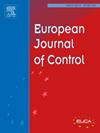有两条生命线的一优一劣追逐者和多诱饵差分赛
IF 2.5
3区 计算机科学
Q2 AUTOMATION & CONTROL SYSTEMS
引用次数: 0
摘要
本文研究的是一种追逐-逃避博弈,在一个二维平面上有多个逃避者和一个卓越的追逐者,平面被两条生命线分为游戏区和目标区。逃避者的目标是到达两个目标区域之一,而追击者的目标是在他们到达生命线之前抓住他们。本文分别构建了无时间延迟和有时间延迟的障碍。对于每个逃逸者,整个障碍将游戏区域划分为逃逸者和追捕者分别占优势的区域。当逃避者的位置位于追逐者的优势区域内时,我们将研究两个逃避者之间的合作和非合作策略。我们考虑了逃避者采取的不同策略以及两条生命线之间的距离变化对追逐者捕获数量的影响。此外,我们还利用阿波罗尼斯圆和笛卡尔椭圆来确定不同情况下逃逸者的最佳目标点。随后,我们将逃逸者的合作策略扩展到多人合作博弈中,将其转化为优化问题,并利用优化算法推导出多个逃逸者的合作策略。最后,本文介绍了各种情况下的数值模拟。本文章由计算机程序翻译,如有差异,请以英文原文为准。
One superior pursuer and multiple-evader differential games with two lifelines
This paper investigates a pursuit-evasion game with multiple evaders and a superior pursuer situated on a two-dimensional plane, divided by two lifelines into the play area and goal areas. The goal of the evaders is to reach one of the two goal areas, while the pursuer aims to capture them before they reach the lifeline. This paper constructs barriers without time delay and with time delay, respectively. For each evader, the entire barrier divides the game area into regions of dominance for the evader and pursuer, respectively. Cooperative and non-cooperative strategies between two evaders are studied when the evaders’ positions are within the pursuer’s dominance region. We consider the impact of different strategies adopted by the evaders and variations in the distance between the two lifelines on the number of captures by the pursuer. Furthermore, Apollonius circles and Cartesian ovals are used to determine optimal target points for the evaders under different circumstances. Subsequently, we extend the cooperative strategies of the evaders to multiplayer cooperative games, transform them into optimization problems, and use optimization algorithm to derive the cooperative strategies of multiple evaders. Finally, numerical simulations for various cases are presented in this paper.
求助全文
通过发布文献求助,成功后即可免费获取论文全文。
去求助
来源期刊

European Journal of Control
工程技术-自动化与控制系统
CiteScore
5.80
自引率
5.90%
发文量
131
审稿时长
1 months
期刊介绍:
The European Control Association (EUCA) has among its objectives to promote the development of the discipline. Apart from the European Control Conferences, the European Journal of Control is the Association''s main channel for the dissemination of important contributions in the field.
The aim of the Journal is to publish high quality papers on the theory and practice of control and systems engineering.
The scope of the Journal will be wide and cover all aspects of the discipline including methodologies, techniques and applications.
Research in control and systems engineering is necessary to develop new concepts and tools which enhance our understanding and improve our ability to design and implement high performance control systems. Submitted papers should stress the practical motivations and relevance of their results.
The design and implementation of a successful control system requires the use of a range of techniques:
Modelling
Robustness Analysis
Identification
Optimization
Control Law Design
Numerical analysis
Fault Detection, and so on.
 求助内容:
求助内容: 应助结果提醒方式:
应助结果提醒方式:


